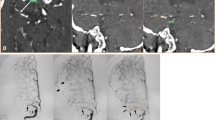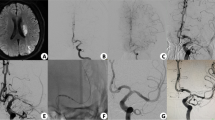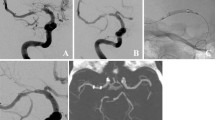Abstract
Purpose
This study aimed to report the clinical findings and initial clinical experience of endovascular recanalization for symptomatic subacute/chronic intracranial large artery occlusion (ILAO) of the anterior circulation.
Methods
From October 2015 to December 2017, 13 patients with symptomatic subacute/chronic ILAO of the anterior circulation were enrolled in this study and underwent endovascular recanalization. We collected the initial procedural results, including the rate of successful recanalization and periprocedural complications, and data pertaining to angiographic and clinical follow-up.
Results
Recanalization was successful in 11 of 13 patients (84.6%). Intraoperative complications occurred in four cases, including symptomatic distal embolism in three cases; one of which was simultaneously complicated with artery dissection. Intracerebral hemorrhage occurred in one case. Eleven patients underwent angiographic follow-up, and 12 patients underwent clinical follow-up. The results of the angiography follow-up (mean 6 ± 3.29 months) showed that in-stent restenosis occurred in one of the 11 successfully recanalized patients. However, the artery was occluded again in the patient who achieved thrombolysis in cerebral infarction (TICI) grade of 2a after treatment. Clinical follow-up (mean 5.8 ± 2.25 months) showed no recurrence of transient ischemic attack (TIA) or stroke in ten successfully recanalized cases. However, the patient who developed in-stent stenosis suffered TIA.
Conclusions
Endovascular recanalization for symptomatic subacute/chronic ILAO of anterior circulation is feasible, relatively safe, and efficacious in highly selected cases, improving patients’ symptoms in the short-term. However, further larger scale pilot studies are needed to determine the efficacy and long-term outcome associated with this treatment.


Similar content being viewed by others
References
Gorelick PB, Wong KS, Bae HJ, Pandey DK (2008) Large artery intracranial occlusive disease: a large worldwide burden but a relatively neglected frontier. Stroke 39:2396–2399
Smith WS, Lev MH, English JD, Camargo EC, Chou M, Johnston SC, Gonzalez G, Schaefer PW, Dillon WP, Koroshetz WJ, Furie KL (2009) Significance of large vessel intracranial occlusion causing acute ischemic stroke and TIA. Stroke 40:3834–3840
Yamauchi H, Higashi T, Kagawa S, Kishibe Y, Takahashi M (2013) Chronic hemodynamic compromise and cerebral ischemic events in asymptomatic or remote symptomatic large-artery intracranial occlusive disease. AJNR Am J Neuroradiol 34:1704–1710
Kuroda S, Houkin K, Kamiyama H, Mitsumori K, Iwasaki Y, Abe H (2001) Long-term prognosis of medically treated patients with internal carotid or middle cerebral artery occlusion: can acetazolamide test predict it? Stroke 32:2110–2116
Yamauchi H, Fukuyama H, Nagahama Y, Nabatame H, Nakamura K, Yamamoto Y, Yonekura Y, Konishi J, Kimura J (1996) Evidence of misery perfusion and risk for recurrent stroke in major cerebral arterial occlusive diseases from PET. J Neurol Neurosurg Psychiatry 61:18–25
Ogasawara K, Ogawa A, Yoshimoto T (2002) Cerebrovascular reactivity to acetazolamide and outcome in patients with symptomatic internal carotid or middle cerebral artery occlusion: a xenon-133 single-photon emission computed tomography study. Stroke 33:1857–1862
Marshall RS, Festa JR, Cheung YK, Chen R, Pavol MA, Derdeyn CP, Clarke WR, Videen TO, Grubb RL, Adams HP, Powers WJ, Lazar RM (2012) Cerebral hemodynamics and cognitive impairment: baseline data from the RECON trial. Neurology 78:250–255
Nogueira RG, Jadhav AP, Haussen DC, Bonafe A, Budzik RF, Bhuva P, Yavagal DR, Ribo M, Cognard C, Hanel RA, Sila CA, Hassan AE, Millan M, Levy EI, Mitchell P, Chen M, English JD, Shah QA, Silver FL, Pereira VM, Mehta BP, Baxter BW, Abraham MG, Cardona P, Veznedaroglu E, Hellinger FR, Feng L, Kirmani JF, Lopes DK, Jankowitz BT, Frankel MR, Costalat V, Vora NA, Yoo AJ, Malik AM, Furlan AJ, Rubiera M, Aghaebrahim A, Olivot JM, Tekle WG, Shields R, Graves T, Lewis RJ, Smith WS, Liebeskind DS, Saver JL, Jovin TG (2018) Thrombectomy 6 to 24 hours after stroke with a mismatch between deficit and infarct. N Engl J Med 378(1):11–21
Albers GW, Marks MP, Kemp S, Christensen S, Tsai JP, Ortega-Gutierrez S, McTaggart R, Torbey MT, Kim-Tenser M, Leslie-Mazwi T, Sarraj A, Kasner SE, Ansari SA, Yeatts SD, Hamilton S, Mlynash M, Heit JJ, Zaharchuk G, Kim S, Carrozzella J, Palesch YY, Demchuk AM, Bammer R, Lavori PW, Broderick JP, Lansberg MG, DEFUSE 3 Investigators (2018) Thrombectomy for stroke at 6 to 16 hours with selection by perfusion imaging. N Engl J Med 378(8):708–718
Yu W, Kostanian V, Fisher M (2007) Endovascular recanalization of basilar artery occlusion 80 days after symptom onset. Stroke 38:1387–1389
Lin R, Aleu A, Jankowitz B, Kostov D, Kanaan H, Horowitz M, Jovin T (2012) Endovascular revascularization of chronic symptomatic vertebrobasilar occlusion. J Neuroimaging 22:74–79
Dashti SR, Park MS, Stiefel MF, McDougall CG, Albuquerque FC (2010) Endovascular recanalization of the subacute to chronically occluded basilar artery: initial experience and technical considerations. Neurosurgery 66:825–831 discussion 31–32
Aghaebrahim A, Jovin T, Jadhav AP, Noorian A, Gupta R, Nogueira RG (2014) Endovascular recanalization of complete subacute to chronic atherosclerotic occlusions of intracranial arteries. J Neurointerv Surg 6:645–648
He Y, Bai W, Li T, Xue J, Wang Z, Zhu L, Hui F (2014) Perioperative complications of recanalization and stenting for symptomatic nonacute vertebrobasilar artery occlusion. Ann Vasc Surg 28:386–393
He Y, Wang Z, Li T, Jiang WJ, Zhu L, Xue J, Bai W, Hui F (2013) Preliminary findings of recanalization and stenting for symptomatic vertebrobasilar artery occlusion lasting more than 24h: a retrospective analysis of 21 cases. Eur J Radiol 82:1481–1486
Lee SH, Suh DC, Cho SH, Sheen JJ, Lee DH, Kim JS (2018) Subacute endovascular recanalization of symptomatic cerebral artery occlusion: a propensity score-matched analysis. J Neurointerv Surg 10:536–542
Gao P, Wang Y, Ma Y, Yang Q, Song H, Chen Y, Jiao L, Qureshi AI (2018) Endovascular recanalization for chronic symptomatic intracranial vertebral artery total occlusion: experience of a single center and review of literature. J Neuroradiol 45:295–304
Xu Z, Ma N, Mo D, Wong EH, Gao F, Jiao L, Qureshi AI (2014) Endovascular recanalization for chronic symptomatic intracranial vertebral artery total occlusion. Minim Invasive Surg 2014:949585
Ma N, Mo DP, Gao F, Miao ZR (2013) Endovascular recanalization for chronic symptomatic middle cerebral artery total occlusion. J Neurointerv Surg 5:e15
Mori T, Mori K, Fukuoka M, Honda S (1997) Percutaneous transluminal angioplasty for total occlusion of middle cerebral arteries. Neuroradiology 39:71–74
Iwata T, Mori T, Tanno Y, Kasakura S, Yoshioka K (2017) Subacute percutaneous cerebral balloon angioplasty for middle cerebral artery occlusion in patients with internal border zone infarcts. J Neurol Surg A Cent Eur Neurosurg 78:25–32
Lü PH, Park JW, Park S, Kim JL, Lee DH, Kwon SU, Kim JS, Yun SC, Suh DC (2011) Intracranial stenting of subacute symptomatic atherosclerotic occlusion versus stenosis. Stroke 42:3470–3476
Bouthillier A, vanLoveren HR, Keller JT (1996) Segments of the internal carotid artery: a new classification. Neurosurgery 38:425–432
Higashida RT, Furlan AJ, Roberts H et al (2003) Trial design and reporting standards for intra-arterial cerebral thrombolysis for acute ischemic stroke. Stroke 34:e109–e137
Puma JA, Sketch MH Jr, Tcheng JE, Harrington RA, Phillips HR, Stack RS, Califf RM (1995) Percutaneous revascularization of chronic coronary occlusions: an overview. J Am Coll Cardiol 26:1–11
Roy S, Sharma J (2015) Role of CT coronary angiography in recanalization of chronic total occlusion. Curr Cardiol Rev 11:317–322
Han SW, Kim SH, Lee JY, Chu CK, Yang JH, Shin HY, Nam HS, Lee BI, Heo JH (2007) A new subtype classification of ischemic stroke based on treatment and etiologic mechanism. Eur Neurol 57:96–102
Samuels OB, Joseph GJ, Lynn MJ, Smith HA, Chimowitz MI (2000) A standardized method for measuring intracranial arterial stenosis. AJNR Am J Neuroradiol 21:643–646
Turk AS, Levy EI, Albuquerque FC, Pride GL Jr, Woo H, Welch BG, Niemann DB, Purdy PD, Aagaard-Kienitz B, Rasmussen PA, Hopkins LN, Masaryk TJ, McDougall CG, Fiorella D (2008) Influence of patient age and stenosis location on wingspan in-stent restenosis. AJNR Am J Neuroradiol 29:23–27
Nussbaum ES, Erickson DL (2000) Extracranial-intracranial bypass for ischemic cerebrovascular disease refractory to maximal medical therapy. Neurosurgery 46:37–42 discussion -3
Tummala RP, Chu RM, Nussbaum ES (2003) Extracranial-intracranial bypass for symptomatic occlusive cerebrovascular disease not amenable to carotid endarterectomy. Neurosurg Focus 14:e8
Touma G, Ramsay D, Weaver J (2015) Chronic total occlusions - current techniques and future directions. Int J Cardiol Heart Vasc 7:28–39
Suh DC, Kim JK, Choi JW, Choi BS, Pyun HW, Choi YJ, Kim MH, Yang HR, Ha HI, Kim SJ, Lee DH, Choi CG, Hahm KD, Kim JS (2008) Intracranial stenting of severe symptomatic intracranial stenosis: results of 100 consecutive patients. AJNR Am J Neuroradiol 29:781–785
Lee DH, Sung JH, Kim SU, Yi HJ, Hong JT, Lee SW (2017) Effective use of balloon guide catheters in reducing incidence of mechanical thrombectomy related distal embolization. Acta Neurochir 159:1671–1677
Chueh JY, Kühn AL, Puri AS, Wilson SD, Wakhloo AK, Gounis MJ (2013) Reduction in distal emboli with proximal flow control during mechanical thrombectomy: a quantitative in vitro study. Stroke 44:1396–1401
Klinger-Gratz PP, Schroth G, Gralla J, Jung S, Weisstanner C, Verma RK, Mordasini P, Kellner-Weldon F, Hsieh K, Heldner MR, Fischer U, Arnold M, Mattle HP, el-Koussy M (2015) Protected stent retriever thrombectomy prevents iatrogenic emboli in new vascular territories. Neuroradiology 57:1045–1054
Matetzky S, Shenkman B, Guetta V, Shechter M, Beinart R, Goldenberg I, Novikov I, Pres H, Savion N, Varon D, Hod H (2004) Clopidogrel resistance is associated with increased risk of recurrent atherothrombotic events in patients with acute myocardial infarction. Circulation 109:3171–3175
Funding
No funding was received for this study.
Author information
Authors and Affiliations
Corresponding author
Ethics declarations
Conflict of interest
The authors declare that they have no conflict of interest.
Ethical approval
All procedures performed in the studies involving human participants were in accordance with the ethical standards of the institutional and/or national research committee and with the 1964 Helsinki Declaration and its later amendments or comparable ethical standards.
Informed consent
Informed consent was obtained from all individual participants included in the study.
Additional information
Publisher’s note
Springer Nature remains neutral with regard to jurisdictional claims in published maps and institutional affiliations.
Rights and permissions
About this article
Cite this article
Ma, L., Liu, Yh., Feng, H. et al. Endovascular recanalization for symptomatic subacute and chronic intracranial large artery occlusion of the anterior circulation: initial experience and technical considerations. Neuroradiology 61, 833–842 (2019). https://doi.org/10.1007/s00234-019-02205-0
Received:
Accepted:
Published:
Issue Date:
DOI: https://doi.org/10.1007/s00234-019-02205-0




